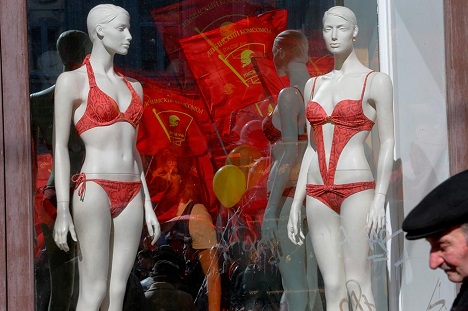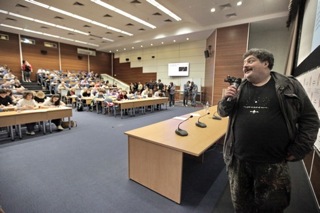Colour symbolism in the Russian language

Red is the brightest colour in the Russian language. Source: AP / Dmitry Lovetsky
The brightest colour in the Russian language and the one that has most positive connotations is red. The word red in Russian (krasny) has the same root as the word beautiful (krasivy), and the meanings of these two words are indeed very close. Moscow's main square is called Red Square. Historically, it is believed, the square was given that name not because of the presence of red buildings on it but because it was considered to be beautiful. So it would have been more appropriately called not Krasnaya but Krasivaya square.
In the early 20th century the word red acquired a new meaning and has since then been primarily associated with communist ideology. After the Bolshevik Revolution of 1917, red became the colour of the national flag, until the collapse of the USSR in 1991. In Soviet mythology, red was considered to be the colour of the bloodshed by the working class in their fight against the yoke of capitalism.
A Soviet person was immersed in red symbolism from their very childhood: from the age of 10 till they became 14, practically all schoolchildren were pioneers and, as a sign of belonging to that youth communist organization, had to wear (at school at least) a triangular red necktie.
After the revolution, the ideological antonym of red was the colour white. It is the Red and the White armies that fought against each other in the 1918-1920 Civil War, in which the White (i.e. regular Russian) Army was defeated and driven outside the country. Its remaining representatives became known as white émigrés, while in the USSR the word white became synonymous with counterrevolutionary and hostile.
Next to red in the rainbow spectrum sits the colour orange, which too has recently acquired some ideological tinge in Russian usage. Following the so-called Orange Revolution that took place in Ukraine some 10 years ago, the word orange began to denote members of the liberal, pro-Western, opposition.
The colours yellow and green have universally accepted associations: the word yellow is used to describe sensationalist press, while the word green is used to denote association with the environmental protection movement.
The word violet in Russian slang is used to describe utter indifference. You could say in Russian: It's all violet to me, meaning: I couldn't care less. However, it is the word blue that has developed diverse and sometimes quite unexpected associations in the Russian language. Traditionally, this colour was a symbol of noble birth and the expression blue-blooded was used to describe members of the aristocracy. In Soviet times, especially in the 1960s, blue became associated with the romance and excitement of exploring and developing remote parts of the country (one of the popular songs of the time, which urged young people to join construction projects in Siberia, was called Blue cities). The word blue was also used to describe far-reaching dreams and aspirations. While the most popular TV program of the time was called Little Blue Light (an allusion to the real colour of the black-and-white TV screen).
Yet, the meaning of the word blue has had its most curious transformation in the last two decades. Once it became possible to openly discuss homosexuality, the word blue became the main euphemism depicting gay people. Moreover, this once peripheral meaning has gradually pushed all the other meanings of the word far into the background. For instance, an absolutely innocent Soviet-era children's animated cartoon called Blue Puppy (about a lonely puppy who nobody loved) has today developed an erotic double entendre that its creators could never begin to anticipate.
All rights reserved by Rossiyskaya Gazeta.
Subscribe
to our newsletter!
Get the week's best stories straight to your inbox

